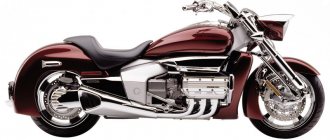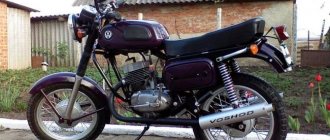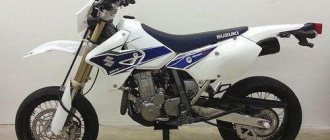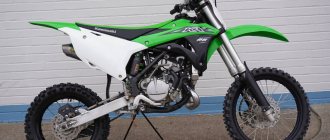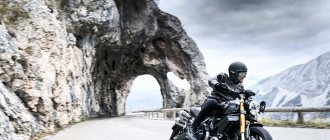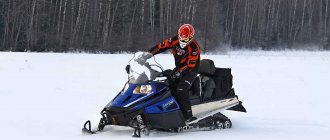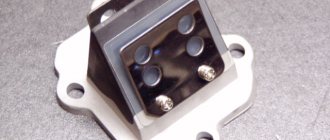BMW Motorrad
is a motorcycle brand of the German company BMW, part of its corporate and brand development division.
[1]
It has been producing motorcycles since 1923 and achieved record sales for the fifth year in a row in 2015.
A total of 136,963 vehicles were sold in 2015, and BMW sales increased by 10.9% compared to 2014. [2]
In May 2011, the 2,000,000th motorcycle produced by BMW Motorrad was the R1200GS.
[3]
MY MOTORCYCLE
Opposite - when I hear this word, pictures of our Soviet cassons, Dnieper, Urals, or the glorious BMW company, which produces (and will continue to produce) motorcycles with this type of engine to this day, immediately pop up. Bavarian bikes with this power unit have thoroughly occupied the niche of touring motorcycles and many cannot create tough competition for them.
But the real legend will forever remain the Bavarian two-cylinder boxer engine with almost a century of history, thanks to which a huge number of motorcycles were born, both in Germany and in other countries. By the way, the Soviet “Ural” and “Dnepr” were also initially equipped with this German power unit, although later the designers started producing copies of the engine.
BMW presented in Cologne (back in 2014) a rather interesting sports tourer for active driving. For those who have been and continue to be fans of “boxer” engines: the BMW R1200RS is a “dressed up” HP2, only with all the goodies and an awesome design. Honestly, the Germans surprise me again. They manage to keep up with the times with the seemingly “outdated boxer engine type” and also create cool, advanced bikes.
The new product is a sports-touring bike, the platform for which, according to some experts, was the naked BMW S1000R, although the designers had to replace its four-cylinder in-line engine with a two-cylinder boxer. The new BMW R 1200 RS combines these credentials with both sharp performance and sporty, dynamic design. The aerodynamic styling of the two-position wind deflector with two headlights forms the attractive face of the new BMW R 1200 RS. Dynamic proportions give the motorcycle sporting prowess and the ability to ride comfortably on the road. The two colors and style finishes highlight the powerful character of the new R 1200 RS in their own individual way.
The wheelbase of the BMW R1200RS was increased by approximately 12 mm to 1529 mm, and the seat was installed a couple of centimeters higher than that of the S1000R. Also, the sports-tourer BMW R1200RS significantly surpassed its predecessor in weight - the curb weight of the new product is 236 kilograms, which is six kg more than that of a naked car.
The power unit of the BMW R1200RS motorcycle has the same 125 horses and 125 Newton meters of torque at 6500 rpm - but thanks to the new airbox and exhaust system, the engine has become more torquey at the bottom. Compared to the engines in the GS, GS Adventure and RT, torque has actually been increased slightly at low revs. Exhaust gases are routed through a 2-into-1 exhaust system with a rear muffler that is sharply angled for a dynamic effect. Also, instead of two radiators, one is placed centrally. In addition, the signature Telelever suspension at the front of the BMW R1200RS has been replaced with an inverted 45mm fork.
The BMW R1200RS motorcycle has been crammed with electronics beyond belief. And it’s so modern and interesting that it’s breathtaking: two, already standard, driving modes “Rain” and “Road”, and in general - Road, Rain, Road Pro and DTC. The first two are installed along with the basic equipment package, the rest are available optionally for an additional fee. Road Pro mode allows the rider to independently make adjustments to the operation of the engine and a number of motorcycle systems, while DTC, also known as Dynamic Traction Control, provides the rider with the maximum possible protection and even care, virtually controlling his every movement. The system takes into account the condition of the road surface, determines whether the surface on which the motorcycle is moving is slippery, constantly monitors the speed of rotation of the front and rear wheels, and in case of deviation from the specified parameters, immediately cuts off the fuel supply to the engine combustion chambers. With such bells and whistles, the motorcycle can compete with modern new cars.
Another electronic feature of the BMW R1200RS is Gear Shift Assist Pro, a system that can change gears without having to press the clutch lever. When this function is activated, downshifts occur as smoothly as possible, almost imperceptibly for the driver. In order to reset one gear, it is enough to completely remove the gas. Upshifts are more noticeable, especially in second and third gears. However, in general, many call Gear Shift Assist Pro not a very popular, although pleasant, option, because the clutch of the BMW R1200RS performs its functions more than adequately, the torquey engine pulls well in the first three gears, and the next three are usually in demand only at high speed. country highway.
Electronic suspension control or ESA (DynamicElectronicSuspensionAdjustment) turned out to be much more useful. This system can independently set the preload and rebound settings of the front and rear shock absorbers depending on the quality of the road surface. ESA has two operating modes - a soft Road, which is suitable for long trips, and a harder Dynamic, which is more suitable for sports driving or high-speed rides. ESA also allows you to adjust the motorcycle's suspension before riding for one or two passengers and luggage.
Overall, the ride on the BMW R1200RS leaves only the most pleasant sensations - the gears shift very smoothly, and the brakes, when needed, prove their reliability every time. By the way, compared to the naked, the sports-touring modification is equipped with more powerful brakes - two 320 mm discs at the front and one 276 mm disc at the rear, which are in the arms of reliable four- and two-piston Brembo machines. They can stop the motorcycle literally on the fly.
Model designation
BMW uses a three-segment nomenclature for motorcycles. The first segment indicates the engine type, the second the approximate engine displacement in cubic centimeters (with one notable exception: the F 650 GS, which has an engine displacement of 798cc [37]
), and the third class is a motorcycle (for example, sport, sport touring, dual-sport, etc.). The three segments are separated by spaces.
A similar 3-segment nomenclature is used for BMW vehicles. However, with respect to the second segment (engine displacement/100), there is significantly less consistency across the entire range.
Engine's type:
- R-air-cooled, horizontally opposed (
- K-water cooled, in-line 3-, 4- or 6-cylinder
- F-water cooled, vertical 1-cylinder (before 2006), vertical 2-cylinder (after 2006)
- G-water cooling, vertical 1-cylinder
- S-line 4-cylinder water-cooled superbike
Engine capacity in cubic meters cm:
- Current models are 1600, 1300, 1250, 1000, 900, 800, 650, 400 and 310. Previous models included 450, 850, 1100, 1150 and 1200.
- Older BMW models divide the approximate engine size by ten for the model number. For example, K75 ≈ 750 cc. cm.
Styling suffix notations:
- B-Bagger
- S-Cruiser
- CS-classic sport
- G/S-Gelände / Strasse Off-road / Street
- GS-Gelände Sport off-road sport (enduro)
- GT-Gran Turismo or Grand Touring
- LS-Luxury Sport
- LT-Luxus Tourer (luxury Tourer)
- R-Road or Roadster is usually naked
- RR racing replica
- RS originally stood for Rennsport, but from 1976 came to stand for Reisesport[41]
- RT-Reise Tourer (tourist Tourer)
- S-Sport
- ST-Strasse (street) or Sport Tourer
- T-Touring
In addition, a bicycle may have the following modifiers in its name:
- ABDOMINAL PRESS
- L-luxury
- P-police
- C-custom
- PD-Paris Dakar
Examples: K 1200 S, R 1200 RT, F 650 GS, R 1150 RSL, K 1200 LT, K 1200 LT-C, R 1200 RT-P, R 1200 RSA, S 1000 RR.
Until the introduction of the K 100 series and R 1100 series motorcycles, the letter prefix was always the same. And the numbers were either based on displacement. As mentioned above. Or they were just model numbers.
Rear suspension
Single-sided rear suspension
The first BMW monolever suspensions appeared in 1980 on the then new R80G/S line. It had a single universal joint just behind the engine/transmission. This system was later included in updated versions of the K&R series.
Paralever
Paralever is another step forward in BMW single-sided rear suspension technology (photo right). It unleashes the torque response as the suspension compresses and extends. Avoiding the tendency to squat or rise when accelerating and reducing tire chatter on the road surface. It was introduced in 1988 with the R 80 GS and R 100 GS motorcycles.
Corrected, inverted Paralever on R1200GS
In 2005. Along with the introduction, this reduces the overhang of components and tends to increase ground clearance in a right-handed lean position.
The figurative term for the lever is a swing arm, and other motorcycle manufacturers have patented similar designs. Including the Arturo Magni for MV Agusta and Magni-Moto Guzzi machines, as well as the compact Moto Guzzi jet shaft drive.
Front suspension
Telescopic fork
In 1935, BMW installed the first production hydraulically damped telescopic fork on its R12 and R17 motorcycles. BMW still uses telescopic forks on its F-series, G-series, HP and S1000RR motorcycles.
The R series, which for several years used only Telelever and Duolever front suspensions,
made a partial return to telescopic forks for the 2015 model year with the introduction of the R 1200 R and R 1200 RS.
[42]
Earls fork
Earles fork on BMW R60/2
The Englishman Ernest Earls developed a unique triangulated fork, which, unlike telescopic forks. Resists lateral forces. Created by strollers. BMW fitted Earles forks to all of its models for 14 years, starting in 1955. In this case, it was the year that stroller use peaked and fell quickly in most European markets (eg UK). But the Earles fork system was also a big hit with solo riders. This causes the front end of the motorcycle to rise when braking - the reverse action of the telescopic fork. The mechanical strength of this design sometimes proved to be a weakness for the rest of the bike. Since it transmitted shock pressure to the frame. Where the damage was more difficult and expensive to repair.
Fork
BMW Telelever front suspension on R1150R
Developed by Saxon-Motodd in the UK in the early 1980s, the Telelever fork aims to improve handling stability when cornering and braking. Telever uses conventional telescopic forks, but the struts only contain lubricating oil. The springing and damping functions are performed by a monoblock attached to the wishbone. The wishbone pivots on the front of the engine block. And the front end of the wishbone is attached through the rose hinge to the bracket. Connecting fork sliders. Because there is no lower triple clamp, the fork sliders are longer and lighter than on a conventional telescopic fork. And greater slider/tube overlap reduces how torsional bending occurs. So is the unsprung weight.
The main advantage of the Telelever system is that... That it separates the steering function from the braking functions and the suspension, the braking forces are retracted rearward through the wishbone. Thereby eliminating brake dive. During braking, the angle of inclination of the caterpillar and wheel (rake) increases, not decreases. Same as with traditional telescopic forks. Some riders accustomed to conventional forks have reported. What Telever may initially lack [46]
but the R1100s BoxerCup Replika (model with its own racing series) shows. That the Telelever fork provides responsive and predictable handling.
The term is a figurative word from
Duolever
Duolever pendant top
In 2004, BMW announced the K1200, which included a new front suspension. Based on a design by Norman Hossack. [ 48]
BMW admitted this fact, but did not pay Hossack any fees.
[49]
BMW named its new front suspension Duolever. From 2022, Duolever is used on all K1300 and K1600 models.
The official explanation of BMW Motorrad duover includes the following:[50]
The advantage of this front wheel suspension in the motorcycle market today is its torsional rigidity. The front wheel suspension of the BMW Motorrad Duolever is not affected by negative forces in the same way as conventional telephores. Fixed and take-off tubes which rotate in the lateral and longitudinal directions during jerk/rebound and steering. Its two tail links absorb shock/rebound forces and maintain wheel support stability. Thus, any torsion is eliminated and the front wheel suspension is very precise. The rider's steering commands are translated directly. And feedback from the front wheel is transparent in all driving conditions.
A kinematic anti-dive effect is additionally achieved. As for Telever, due to the location of the rear link bearings. While a regular telefork sways or gets blocked during strong braking maneuvers. The Duolever still has plenty of spring travel. Remaining in this situation. And so the rider can still brake into the corner very late. But in the direction of sustainability.
- ^ a b
Deliveries as of December were 10.9% higher than the previous year. BMW Motorrad's strategy takes effect. Archive from the original on 2016-09-27. Retrieved 2016-09-26. - . autoevolution.com May 13, 2011. Archived from the original on May 19, 2011. Retrieved May 13, 2011.
- Downs, Andy (November 11, 2015). . News About Motorcycles
. Archived from the original on February 1, 2016. Retrieved January 30, 2016. - Sunny, Ken (November 12, 2015). . International Business Newspaper Archived from the original on March 5, 2016. Retrieved January 30, 2016.
- . Production capacity
. BMW Group. Archived from the original 2008-12-11. Retrieved 2008-09-18. - Ash, Kevin (January 30, 2012). . News About Motorcycles
. Archived from the original on May 2, 2012. Retrieved July 15, 2012. - . Visiondown
. January 30, 2012. Archived from the original on February 4, 2012. Retrieved July 15, 2012. - Madson, Bart (January 30, 2012). . Motorcycle USA
. Archived from the original on February 1, 2014. Retrieved July 15, 2012. - . webBikeWorld.com February 5, 2010. Archived from the original on May 13, 2010. Retrieved February 18, 2010.
- . Biker Voodoo. Archived from the original on 2008-05-06.
- Ziegler, Jessie. . Motorcyclist. Archived from the original on December 29, 2008. Retrieved 2009-01-07.
- . China Economic News Service (CENS). July 3, 2008. Archived from the original on February 21, 2009. Retrieved 2009-01-09.
- . Visiondown. Archived from the original on February 21, 2009. Retrieved 2009-01-09.
- Brisette, Pete (December 15, 2008). . Motorcycle.com archived from the original on January 30, 2009.
- Madson, Bart (July 2, 2010). . Motorcycle USA. Archived from the original on July 5, 2010. Retrieved July 22, 2010.
- Organization, A.S.O.-Amur Sports. . www.dakar.com
. archived from the original on 2016-09-19. Retrieved 2016-09-18. - (PDF). Dakar. Archived from the original (PDF) in 2010-06-01. Retrieved 2009-01-07.
- . Motorsport Etc. Archived from the original on December 27, 2008. Retrieved 2009-01-07.
- . carolenash.com
archived from the original 2018-03-26. - . www.press.bmwgroup.com
archived from the original on December 20, 2016. Retrieved May 9, 2018. - . www.iomtt.com
. Archived from the original on August 28, 2022. Retrieved May 9, 2018. - (PDF). Archived (PDF) from the original on 06/2016/15. Reviewed 2016-06-04.CS1 maint: archived copy as title (link)
- . www.iomtt.com
. Archived from the original on August 23, 2022. Retrieved May 9, 2018. - Omorogbe, Jane (April 3, 2008). . MSN. Archived from the original on July 23, 2011. Retrieved November 11, 2009.
- https://classic-motorbikes.net/wp/bmw-r90s/
- ^ a b Which Bicycle
: 39. Summer 2004. - Cameron, Kevin (December 21, 2012). . World of Cycle. Retrieved June 27, 2022.
- Brown, Roland (February 2, 2014). . Telegraph.
- . BMW Motorrad Germany
(in German). Retrieved 2020-04-04. - Ker, Rod (May 2005). . Morton Way, Horncastle, UK: Mortons Media Group. Archived from the original on 05/02/2013. Retrieved 2013-05-23.
- BMW Archived 2019-04-20 on the BMW Wayback Machine technology website
- Madson, Bart (July 2, 2010). . Motorcycle USA. Retrieved July 22, 2010.
- ^ A b c
Hull, Matt.
RiDE Magazine
(September 2010): 123. ISSN 1360-3507. - Madson, Bart (November 10, 2009). . Motorcycle USA. Retrieved July 22, 2010.
- Ash, Kevin (25 August 2010). .
- . Archived from the original on 2016-03-03. Reviewed 2020-06-25.CS1 maint: archived copy as title (link)
- BMW Motorrad Deutschland Archived 2008-03-15 at The Wayback Machine
- BMW motorcycles: bikes: F 650 GS Archived 2008-03-02 at The Wayback Machine
- . Archived from the original on 2016-08-09. Retrieved 2020-06-25.
- BMW Motorrad (6 October 2008). . Motorcycle.com. Retrieved November 19, 2012.
- Wilson, Byron (September 30, 2014). . MotorcycleUSA.com
archived from the original 2014-11-11. Retrieved 2014-11-11. - Falloon,
original BMW air-cooled Boxer Twins 1950-1996 , pp 13-14 - Holmstrom & Nelson
, p. 64 - Patent GB693646, Earles, Ernest,
- . Visiondown
. September 14, 2010. Archived from the original on December 26, 2014. - What Bicycle?
: 41. Summer 2004. - . Design by Hossaka. Retrieved March 22, 2010.
- Archive 2018-09-04 on the Wayback machine, broughsuperiormotorcycles.com
- . BMW Motorrad. Archived from the original on June 26, 2006. Retrieved March 22, 2010.
1200 cc twin-cylinder boxer engine. cm.
BMW Motorrad's twin-cylinder boxer engines have been a source of delight for motorcyclists for over 90 years. Power, torque, amazing sound and exemplary reliability. Today BMW Motorrad offers two lines of boxer engines - 1170 cc. and air-oil cooling for the R nineT model family with a volume of 1254 cc. with air-liquid cooling and ShiftCam technology for R, RS, RT, GS and GS Adventure models.
BMW R nineT Scrambler with 1200 cc twin-cylinder boxer engine. cm.
Designed for higher speeds, the new counter-flow twin engine has two chain-chain camshafts (DOHC) for each cylinder with valves actuated by optional lightweight high-speed roller followers. The radial arrangement of the four valves allows for a very compact combustion chamber design. As with the previous model, the mixture is ignited via two spark plugs. The previous 12.0:1 compression ratio is also maintained, while knock control allows the use of Super (plus) fuel with octane ratings of 95–98. The rated load capacity is determined at 98 octane.
The R nineT engine has two chain-chain camshafts (DOHC) for each cylinder with valves actuated by additional lightweight high-speed roller cams. The radial arrangement of the four valves allows for a very compact combustion chamber design. As with the previous model, the mixture is ignited via two spark plugs.
The camshafts are positioned horizontally in the direction of travel on the engine - so each camshaft controls one intake and exhaust valve, and the cams are tapered due to the radial arrangement of the valves. The timing of the intake and exhaust ports for the two camshafts has been optimized to achieve maximum torque in the low and mid range.
Don't rush the process
Buying a motorcycle can be a lengthy process. And it's usually an important financial investment for your riding career. Be sure to take the time to buy a motorcycle. Browse through a few of them before making your choice. Make an informed decision and don't rush to buy a motorcycle right here and now. If the bike doesn't live up to your expectations or the deal doesn't seem right to you.
Buying your first motorcycle may seem like a daunting adventure, but it doesn't have to be. Do your research ahead of time while you're shopping. Whether online or walking through the dealership for your first purchase. Ask the seller a few questions in advance if you are interested. When it's time to look at the bike in person, pay attention to all the details we've mentioned. And be prepared to ask a lot of questions. Enjoy your test drive and be aware of everything you find on your trip. And when the deal is right. Make a fair offer. Enjoy your new purchase and be sure to get it home safe and sound. To get gear for your maiden voyage. Remember ATGATTA and be safe there!
Download our free used motorcycle checklist today!
New roadster
After the successful debut of the boxer engine installed on the flagship R1200GS, the Bavarians decided to switch their other models (with the exception of the R NineT) to this type of engine. As for the BMW R1200R, installing an engine on it also entailed replacing the suspension. I had to abandon the Telelever (the design clearly eliminated the “dive” of the bike during emergency braking) and return to the usual system - an inverted fork with a diameter of 45 mm. The thing is that the Telelever lever did not allow the radiator to be installed. Below is a little history of the modernization of the BMW R1200R: 1. 2006 (July) - start of production, start of sales, the new motorcycle received the factory index K27. 2. 2011 - release of the second generation K27 (BMW R1200R); 3. End of 2014 - the third generation of the motorcycle, now receiving a new index K53, which is still produced to this day.
Take a test ride
Conducting a test drive is a complex topic because there is a lot of responsibility for all parties. A private seller may not let you ride a motorcycle, and if they do, they probably will. They will be waiting. That you will leave something in return (perhaps a car) or want some form of money. To hold a motorcycle. If you get into an accident while riding it, it's still their motorcycle and insurance can't cover the damage. Because you are not insured on it. The dealership will likely let you test ride the motorcycle. But this is still a debatable issue. It is their right to refuse you a trip.
If you take the bike for a test ride, don't worry too much if it doesn't feel right. That it's not perfectly tuned for you. Most likely, this will be the case. Now is the time to feel and hear how well the motorcycle performs. You have already completed a pre-ride visual inspection of your motorcycle. Listen for strange sounds such as squeaking, scraping, and loose components. Do the bearings squeak when the suspension moves or when the wheels turn? Can something sound free through vibration? Do you feel the softness of the brakes when you stop? Watch and listen for any red flags that just don't seem right. Anything you find will need to be discussed with the seller or dealer and that's it. What needs to be fixed is possible. Will need to be added to future purchase price.
Suspension
For the R1200R, a new frame was developed, consisting of a pair of subframes attached to a supporting element - the BMW R1200 engine. The Evo prefix was added to Paralever, a cantilever rear suspension. In addition, the locking side is now from right to left. As an option for BMW boxer motorcycles, Dynamic ESA is available - electronic suspension adjustment. Its task is to change the operating mode of the shock absorber depending on the driving style and type of maneuvers. ESA BMW R1200R operates in two modes:
- Dynamic;
- Road.
This makes it possible to give the chassis of BMW boxer motorcycles a hard or soft performance style.
Engine
As standard, thanks to electronic gas, a pair of engine operating modes for the BMW R 1200 are available: road and rain. The standard also includes:
- ABS;
- ASC (directional stability - increases safety when accelerating suddenly).
Riding Pro is available as an option, and you get DTC - dynamic traction control, equipped with a tilt sensor. Plus, a couple of riding modes will appear: User (set by the motorcyclist himself) or Dynamic (sports). But there is a logical point here: the R1200R is designed for movement in urban environments, so User mode makes little sense.
It’s unlikely that anyone can customize a bike better than the designers themselves, and if you “turn off” all the electronics, this will only lead to a decrease in safety. the R1200R has 125 hp. With. and 125 N*m, which can easily rear up the equipment if handled carelessly. Therefore, it’s still not worth turning off the electronic systems, unless you have to go out on the track.
It is worth telling in more detail about the engine itself and its features. In it, the cylinders are located opposite each other, which reduces the center of gravity. Another plus is the reduction of vibration, since the movement of one piston balances the stroke of the second, thanks to vibration forces. These characteristics are especially important for two-wheeled vehicles.
Before You Buy
There are many options to buy a used motorcycle. These include private sellers on your favorite sites like Craigslist, Cycle Trader, and motorcycles on Autotrader, a larger search result from Google or Bing, or you can simply find your local motorcycle dealerships and pay them a visit.
It's always a question: "We've put together a few things to think about. When you're browsing the classifieds and before you decide to look at a few used motorcycles in person.
Some basic technical characteristics
1. BMW R1200 engine: two-cylinder injector, four-stroke, volume 1170 cc. cm, power 125 l. With. at a peak torque of 125 N*m and 6500 rpm. 2. Transmission: six-speed manual transmission, paired with a multi-plate fluid clutch (oil bath), cardan drive. 3. Suspension: front - inverted telescopic fork with 140 mm travel. The rear is a Paralever cantilever swingarm made of cast aluminum, plus a monoshock absorber that can be adjusted for spring preload and rebound hydraulics with a stroke of up to 140 mm. 4. Brakes: front - two-disc, rear - single-disc. 5. Speed up to 231 km/h. 6. Fuel tank 18–21 l. 7. Weight 198–231 kg.
Douglas and BMW: the first signs
The first manufacturer of motorcycles with a boxer engine was Douglas from Bristol, England. Around 1905, its engineers developed the first two-cylinder engine with a 180-degree camber and a displacement of 200 cm³. Later, motorcycle engines with a displacement from 350 cm³ to 1 liter were created. All of them were distinguished by a “square” piston stroke (the cylinder diameter is equal to the stroke length) and a longitudinal arrangement of the cylinders. Also a signature feature of Douglas bikes was the belt drive to the wheel.
Around 1920, the design of Douglas engines was analyzed and revised by engineers at the young BMW company from Bavaria. The result of this work was the first boxer engine, the M2B15. This engine was used in the prototype Helios motorcycle of 1920. The bike's engine also had a longitudinal orientation of the cylinders, but the drive to the wheel was realized by a chain, not a belt.
The advantage of the longitudinal arrangement of the engine (with a transverse crankshaft) was the absence of the need to use helical gears. The transmission consisted of easier-to-manufacture straight-toothed gears, chains, shafts, pulleys, and belts. But the powerful boxer engine with longitudinal cylinders turns out to be very long and difficult to fit under the frame. In addition, the crankcase blocked the flow of oncoming air to the rear cylinder, causing it to overheat. Therefore, the appearance of engines designed for transverse installation (cylinders on the sides) became quite logical.
The first motorcycle with a transverse engine was the 1923 BMW R32. It was equipped with a half-liter M2B15 engine with a power of 8.5 hp. s., accelerating the bike to 95 km/h. For transverse installation, the engine was modified; a clutch and 3-speed transmission unit located at the rear was connected to the crankcase of its engine. For the first time on a boxer motorcycle, a wet sump with gearbox lubrication was used. Another innovative solution for motorcycles was the drive to the wheel using a cardan shaft.
It is the BMW R32 that can be considered the prototype of a modern motorcycle with a boxer engine. In further history, the only fundamental innovations in the design that can be distinguished are the suspension on shock absorbers. The R32 did not have them: the rear wheel was rigidly mounted, simple springs under the saddles were responsible for the comfort of the driver and passenger, and the front fork was equipped with a quarter-elliptical spring. Probably, at speeds close to maximum, the shaking on such a bike was quite noticeable, but for its days the BMW R32 was a very advanced motorcycle.
conclusions
The updated BMW R1200R boxer motorcycle is a typical urban roadster, intended more for European youth. However, for ours, this bike may not seem as charismatic and brutal as we would like. Rather, the motorcycle is ideal for those who are closer to... 40.
And yet, in the case of the R1200R, the engineers managed to combine into one almost without loss the qualities necessary for driving around the city and beyond. It has good handling, a stable chassis, comfortable seats and a riding position where your back doesn't go stiff after 30 minutes of driving, plus a responsive engine. And if this motorcycle is equipped with a windshield and panniers, you will get a good “tourist”: not boring and comfortable.
Source
Negotiation
Once you've decided you want to buy a motorcycle, it's time to negotiate a price. At this point, you've already done your research to find out what the fair market price for the motorcycle is. This includes a fair price (most likely a price range), any changes. Which may affect the price. Any future maintenance needs. Which may add to the purchase price. And any damage. Which could have happened in the past. Before asking if the seller is negotiable, put yourself in their shoes. Is their price fair? What would you say if you were a seller and someone asked you to pay a different price? The seller may be a little overpriced and may be able to move to lower the price. Politely ask if they are negotiable on price. If so, be prepared to make an offer with a specific dollar figure. Be the person who offers first and don't ask the seller how low they can go. Offer what you're willing to pay and work up to the final price from there if necessary.
BMW R 1200 RS - sport tour with boxer engine
In 1976, the German concern BMW released the first motorcycle, the BMW R 100 RS. Notably, this is the first production bike to have a full fairing that is attached to the frame. It was from that moment that the history of the Bavarian manufacturer in the development and creation of sports and touring motorcycles equipped with opposed power units began.
The history of the BMW R 1200 RS
Almost simultaneously with the release of the latest generation BMW R 1200 R, fans of the brand were offered another model, completely covered with a fairing. The R 1200 RS is a bike with the appearance of a sports bike and the character of a Bavarian boxer. This bike is a universal solution for those who like to use their two-wheeled vehicle for long journeys and daily trips around the city. The BMW R 1200 RS not only has weather protection, but is also equipped with a full range of modern electronic assistants.
BMW has an excellent and very long tradition of producing its roadsters in several versions, which are designed for any operating conditions. The R index in the name indicates that this is a naked-style bike, mainly aimed at urban everyday riding, RT - that this is a large touring machine that is ideal for long trips and travel, but is not very convenient for daily trips to work.
The RS series bikes are something in between, an intermediate option, created for all needs at the same time. The concept of creating BMW RS series bikes involves a comfortable riding position and effective wind protection.
In 1976, the BMW R 100 RS became the first representative of this manufacturer to be tested in a wind tunnel. Since then, the fairing design has only been improved.
Technical features of the BMW R 1200 RS
The latest generation of the R 1200 RS differs from previous models not only in its technical content, but also in its appearance. This is no longer a huge motorcycle, but a fairly compact device that resembles a sportbike. Of course, an experienced motorcyclist will immediately determine what kind of model it is, but others are unlikely to be able to recognize which class it belongs to.
Despite its sporty appearance, the BMW R 1200 RS does not imply the embryonic fit of a classic sportsbike. The seating position is slightly lower than on a naked bike, but is upright enough to not put too much strain on the rider's arms and back. At low speeds, the landing position is relaxed, and when accelerating to 200 km/h, the rider’s body falls completely on the air flow, making him almost weightless. At the same time, the air does not blow too much, and the motorcycle racer does not feel any unnecessary discomfort.
The fairing perfectly protects the rider from precipitation. This allows you to move comfortably in short-term light rain or get to shelter in heavy rain. The motorcycle windshield has two working positions.
Due to the fact that the bike is equipped with numerous electronic systems, an electric windshield would be nice as an additional option. However, adjustment is carried out exclusively manually. So, if it starts to rain, you will have to make an unscheduled stop to adjust the windshield. In all other areas, the automation of the BMW R 1200 RS is at the highest level.
Of course, the motorcycle has ABS and traction control, which most advanced models are equipped with today. A rarer option that can be found on this bike is an electronic ignition switch. Simply put the key in your pocket, after which you can start the motorcycle or lock the steering wheel using a button. Using another button you can open the gas tank.
Content
BMW's first motorcycle, the R32
The company began as a manufacturer of aircraft engines in the early 20th century and during the First World War. BMW released its first motorcycle in 1923,
R32, which featured a flat twin boxer engine. BMW Motorrad continues to use the flat-twin boxer configuration. But now it produces motorcycles with various engine configurations.

